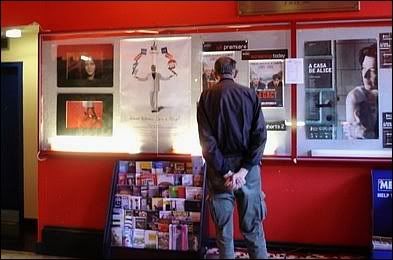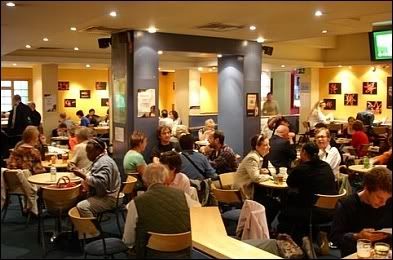
What makes this festival so good? Large scale, but nowhere near Cannes or the Berlinale in size, it has the reputation of being high quality, friendly and laid back, all of which it is. But its focus on the core of what cinema is about – its writers, actors, directors, technology and preservation, its future and above all its history, is so sharp and committed that I would add the word “intense”. An abundance of quality events to choose from, you can greatly enhance your knowledge of cinema at this festival. Renowned actors and directors, Mike Leigh, Tilda Swindon, Bob Hoskins, Stephen Frears and others come to pass on knowledge of their trade, and interact freely with those attending the festival’s many forums, conferences and workshops. The venue is exceptional and there is a wide choice world cinema – classic, quirky, experimental, documentary, first tries.

The EIFF paid homage to the legendary screen writer Anita Loos with a retrospective of her films. From her first days with Biograph and Griffith in the early 1900s, Anita Loos went on to become one of the highest paid screenwriters in Hollywood. Famous for her shady lady stories, so coveted by Joan Crawford, Garbo, Harlow, she could be counted upon to get past the censors with the “telling innuendo and the delicate double entendre”.
Most remembered for Gentlemen Prefer Blondes, originally a series of sketches in Harper’s Bazaar, her best films are from the 1930s-40s. Time has not left these films behind. Their dialogue, razor sharp, witty and urbane, shames most of the current Hollywood writing committees. And who, in this age of tortuously complex men-women relationships, could forego the pleasures of 1940s love talk and seduction games in these graceful films about the eternal cycle of men and women loving, splitting, reconciling, with their winners and losers (and of course an abundance of mansions and family servants to smooth things over in the background). Alive, dynamic, generous, these films have many things to say today. My hit list includes:
Saratoga (1937, Jack Conway) with the bombshell of the 1930s, Jean Harlow, who died at age 29 during the filming, and a raffish, elegantly seductive young Clark Gable, not forgetting Lionel Barrymore.
Susan and God (1940, George Cukor), with a deliciously funny Joan Crawford and a very young Rita Hayworth. High comedy in any age and contemporary in theme: a self-centred New York socialite freaks out on God, but in 1940s glamour style with shades of black and creamy whites. Her neglected daughter and husband bide their time in the background. Audiences of very mixed ages laughed their way throughout. Why no DVD?
The Women (1939, George Cukor) with Norma Shearer, John Crawford, Rosalind Russell, Paulette Goddard. More than two hours of upmarket Manhattan bitchiness at its best. In an all star cast of women scorned, men are dissected mercilessly, then reconstituted to love once again.
Thanks to the excellent presentations of Cari Beauchamp, her own mix of solid scholarship, respect for her subjects and spicy star gossip, festival goers rediscovered these miracles of lost grace and beauty. I strongly recommend her books: Anita Loos rediscovered: film treatment and fiction by Anita Loos, creator of Gentlemen prefer blondes (co-authored with Mary Anita Loos, University of California Press: 2003), and Without lying down – Francis Marion and the Powerful Women of early Hollywood (University of California Press, 1997)
Edinburgh is a city that supports cinema. There are at least two dynamic independent theatres dedicated to world cinema and classic re-issues, the Cameo Picturehouse and the Film House. The film studies department at the University of Edinburgh screens at both, maintaining a dynamic link between the public and formal study of film.  Both of these theatres are jewels from the past. The Cameo, a 3 screen cinema founded in 1914, is one of the oldest surviving cinemas in Scotland. It retains much of the original lush décor, today faded by time and loving use, except for the main auditorium which has been restored to its full Edwardian splendour. In 2005, public outcry stopped promoters from turning it into yet another bar-restaurant and the Cameo stayed what it was meant to be.
Both of these theatres are jewels from the past. The Cameo, a 3 screen cinema founded in 1914, is one of the oldest surviving cinemas in Scotland. It retains much of the original lush décor, today faded by time and loving use, except for the main auditorium which has been restored to its full Edwardian splendour. In 2005, public outcry stopped promoters from turning it into yet another bar-restaurant and the Cameo stayed what it was meant to be.
Its main competitor (friendly), the Film House, considered the home of the festival, is just a 3-minute walk away and has one of the most dynamic cinema atmospheres anywhere. Old, beautiful and creaky, the Film House used to be a church. The remaining stained glass widow is visible only from the projection room. Amidst arches, pillars & vaults, you can purchase great DVDs – classic, cult & obscure – and cinema books.
The restaurant-bar, open all hours, even for breakfast, is noisy with film talk. The menu is cheap and innovative, and ordering, getting a seat, and seeing it arrive at your table during festival time is a fun ordeal that you will have to discover for yourself. It's one of best festival meeting places. 
Although Cineworld, the multiplex used by the 2007 festival is more suitable than Strasbourg’s alienating hypermarket version, festival screenings there, in spite of the peaceful little bar on the first floor, seem as off key as Mireille Mathieu belting out Blind Lemon Johnson. 
Restoring classic films (in collaboration with Martin Scorsese’s World Cinema Foundation); Mike Leigh giving advice to young movie professionals and talking about his own film making techniques: screenings of a re-mastered Berlin Alexanderplatz; three Shakespeare films with Laurence Olivier; and many many others.
Dates for the 2008 festival: 18-29 June.
See: http://www.edfilmfest.org.uk
Butterfly Woo Dip. Traduction en cours...
Traduction en cours...

EIFF 2007
Inscription à :
Publier les commentaires (Atom)
















Aucun commentaire:
Enregistrer un commentaire